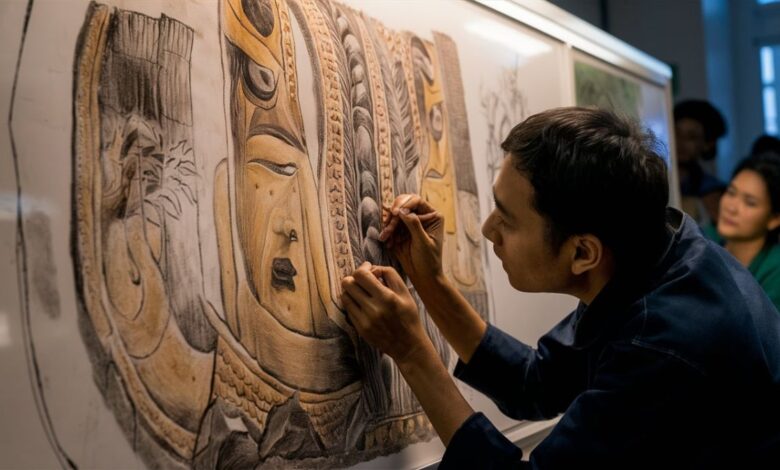The Progression of Ancient Arts: Exit, Imperfect Antiquity. Enter, Classical Civilizations

Ancient artz represent the heartbeat of humanity and the recounting of tails from this world for eons. Such creative insights have shaped cultures and societies while at the same time impacting the current forms of Art. The vivid imagery of cave paintings or small nuts in shaped Art, made by dusting today’s Art, serves the same proper breathing into oneself the life and faith of the ancient world. It is an important reminder that every one of us has been touched by the urge to create.
Examining the historical context of these great arts — from the age of relics to that of antique cultures — it’s impossible to limit oneself without comprehending the general development. Come with us as we take you back to see what standard features exist in contemporary society as influences from ancient arts.
Introductory paragraph highlighting the importance of ancient arts and their impact on modern society
Ancient arts and culture are not only dull history; they are the foundation of present-day creativity. These primitive forms of expression uncover the minds, feelings, and faith of the people of the past. These works of Art enlighten us that Art was and is an essential aspect of human beings.
We have all heard about or seen great things that depict ancient styles or patterns, and this movement cuts across from the fine arts to the digital world. Many themes, including symbolism, were first portrayed in these early pieces of Art, and such themes are carried on in the art narratives of today.
Further still, ancient Art enhances cultural belonging and continuity. It reproduces WikiCultural history for generations to come to preserve it with time. This fondness for such a basic form also fuels the love of culture and education.
Like other movements, artistic movements also refer to the ancient period to draw out innovations and new ideas that seek to bridge the old with the contemporary. Such a relationship broadens comprehension and makes possible new approaches to creativity worldwide.
Prehistoric Art – Cave Art, Rock Art and Megaliths
History bears witness to the fact that prehistoric Art performed the function of human expression in its most fundamental form. Images such as those in the caves of Lascaux and Altamira include animal figures and even scenes from people’s lives. This beautiful representation brings us back to the time of our forefathers.
The scope of rock art takes this narrative a step further by going beyond the walls. The petroglyph engravings depict acts of ceremonial activities or tribal motifs. Such messages encapsulate beliefs and their organization, reaching a time long lost.
Megaliths have been known throughout world history as one of the ultimate achievements in engineering and architecture. One can easily pose the question and be amazed by the answer as to what they are and about the people who built them, for instance, Stonehenge. Were they, in fact, astronomical indicators, religious parentheses that were probably temples, or simply Sites for people to congregate?
Every artifact of a prehistoric piece of Art has an answer to how the maker’s mind worked. The Art shows that the structures were built within people and nature as a way of life long before writing developed.
Mesopotamia Art: Cuneiform script, cylinder seal, Ziggurats.
The Art and architecture of Mesopotamia are riveting, especially because it was one of the cradles of civilization. One cannot forget the other incredible innovation—cuniform, which opened new horizons in keeping records and telling clay tablet tales. It changed the way people communicated and thus gave rise to the concept of writing.
Cylinder seals were another of the many innovations that the Mesopotamian region possessed. These tiny stones were carved more for artistic than functional purposes. They had images of ordinary, mythological, or regal life that became engravings upon clay when the cylinder was spun over wet clay.
Ziggurats stood great above terrains as hypotheses and tacos to God. Their increasing complexity indicated the high development of architecture yet demonstrated the connection between mankind and higher beings. Each circle took the audience closer to their deities.
Art served not only as a simple decorative form; the existence of those components indicates a lot of the philosophy and ideas underlying art.
Hieroglyphics, Pyramids, and Funeral Rites as Egyptian Art
Boy, this piece of Art belongs to this civilization and harmonizes, testifying to its sophistication. Texts are commonly inscribed on the walls of temples and tombs, communicating deep stories; these are the hieroglyphics. This is because each sign depicts something and speaks out about their life, religion, and culture.
The pyramids are another splendor of ancient Art. These architectural advances were not merely royal burial chambers. They epitomize power that aspires to eternity. After construction, they were carefully and accurately put up, as skills in construction are still admired today.
Funeral rites are reflected in the Egyptians’ view of life beyond this world. Summary: Rich In Art And Civilisation, Egyptian history repeatedly emphasized death. Inviting Lodge discussed portraying scenes for changing funeral rituals in Egypt.
The elements have, in totality, presented a discernible understanding of the life of the Egyptians. The artistic ability is done in relation to and as an extension of intense religious belief and love for the city and invention. Even this elaborate history continues to appeal to today’s artists and historians.
Pottery, Sculpture, and Architecture: Greek Art
To put it mildly, Greek Art is history itself. Therefore, pottery was decorated for practical use and aesthetic appeal. Mycenaeans particularly developed skills in black figure ware and red-figure vase painting, which included depictions of mythical and real-life activities.
This was the age where sculpture reached its zenith. People like Phidias chiseled out forms of gods and athletes that glorified the human physique. Such works were portrayed proportionately, dynamically, and authentically.
The ancient Greeks also excelled at architecture. Temples dedicated to the gods were lavishly adorned with massive pillars and sculptural decorations. Even today, the Parthenon is known as one of the landmarks of classical architectural style.
These features combine the realization of artistic talent and the values of a culture whose relevance is felt even today. Every piece has a history of faith, conquest, and customs, which still perpetuates in the modern world in the practice of artistic works.
Roman Art: Mosaics, Fres
Let’s begin with a brief overview of what has passed and where we are heading in Roman Art. The Romans skillfully used the elements they found in the civilizations they conquered, especially in Greece and Etruria. Such versatility is characteristic of their Art.
The most common trait of artistry in the Roman era and throughout the centuries is that mosaics became the premier artwork in Roman Art. These ornamental designs, consisting of tiny pieces of colored glass or stone, were incorporated into floors and walls as public and private decoration. They illustrated myths, daily life, or the surrounding world while stunning the viewer with their beauty and the Art of narration.
Frescoes played an important part in the decorations of Roman homes as well. They were painted on wet plaster, and these brightly colored images adorned the interiors of villas and temples. Perspective created the first illusion of depth in paintings.
In addition to these purposes, mosaics and frescoes highlight the complexity attained by Roman civilization on a more fundamental level, as they did in enhancing the appearance of their dwellings. Quite a lot of these epochs helped us to reconstruct the way of life of the people who lived then. While considering the impact of ancient Art on the modern world, it becomes evident that development is a uniform line, with each of the following civilizations enhancing the progress made by the preceding one.
Such reining influence makes us adore ancient Art because each of them is still very much felt today—be it in urban design, ornamentation, clothing, or any other factor—making it evident that inventiveness has always transcended temporal boundaries.
Discover More: https://magazineslash.com/





